Virtual Tour: The Campus[Next] __ [Previous] __ [Overview] __ [Help] __ [More Info] |
Virtual Tour: The Campus[Next] __ [Previous] __ [Overview] __ [Help] __ [More Info] |
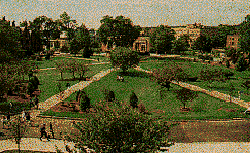 It is not easy to show the whole campus, so we will just present some
highlights ... The green
is the
metaphysical center of the Seton Hall Universe. Lots of hanging out. It
is a useful meeting point for debating professor's views and making plans
with friends. Some sunbathing is allowed.
It is not easy to show the whole campus, so we will just present some
highlights ... The green
is the
metaphysical center of the Seton Hall Universe. Lots of hanging out. It
is a useful meeting point for debating professor's views and making plans
with friends. Some sunbathing is allowed.
 The Immaculate Conception Chapel is a haven for meditation and quiet
reflection. Its stained-glass windows, made in Munich, depict the
creation and bestowal of the sacraments, as well as some apostles
and famous priests whom seminarians in former days were urged to
emulate. A small oratory is dedicated to St. Elizabeth Ann Seton.
Using Virtual Reality, you can actually enter the chapel.
The Immaculate Conception Chapel is a haven for meditation and quiet
reflection. Its stained-glass windows, made in Munich, depict the
creation and bestowal of the sacraments, as well as some apostles
and famous priests whom seminarians in former days were urged to
emulate. A small oratory is dedicated to St. Elizabeth Ann Seton.
Using Virtual Reality, you can actually enter the chapel.
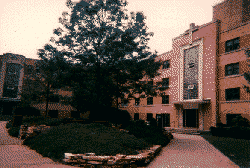 Boland Hall is actually two structures. South Boland was built in the 1950s and holds approximately 299 students. North
Boland, built in the 1960s, houses 467 students. Residences include
lounge areas. This is where all of Seton Hall's residential freshmen live
together. It also houses the Student Health Center and the Campus Ministry Complex.
Boland Hall is actually two structures. South Boland was built in the 1950s and holds approximately 299 students. North
Boland, built in the 1960s, houses 467 students. Residences include
lounge areas. This is where all of Seton Hall's residential freshmen live
together. It also houses the Student Health Center and the Campus Ministry Complex.
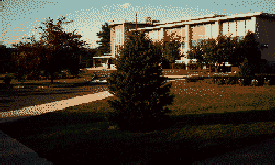 The Student Center houses most of Seton Hall's cultural, social and recreational activities and is named for Bishop John J.
Dougherty, president of Seton Hall from 1960 through 1970. This modern building contains the Galleon Room. If
you're looking for food, you can find it here. Eighteen different stations offering everything from donuts to egg rolls can be
found in the Galleon Room. This is the main campus dining facility. An art gallery, the Theatre-in-the-Round, a student study
lounge, student publications, student government offices and a television viewing area can also be found in the Student
Center.
The Student Center houses most of Seton Hall's cultural, social and recreational activities and is named for Bishop John J.
Dougherty, president of Seton Hall from 1960 through 1970. This modern building contains the Galleon Room. If
you're looking for food, you can find it here. Eighteen different stations offering everything from donuts to egg rolls can be
found in the Galleon Room. This is the main campus dining facility. An art gallery, the Theatre-in-the-Round, a student study
lounge, student publications, student government offices and a television viewing area can also be found in the Student
Center.
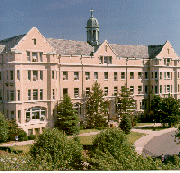 Mooney Hall is named in the honor of Monsignor James Mooney, president of
the University from 1907 to 1922. Mooney
Hall was the main college building, providing classrooms downstairs and housing and study lounges upstairs. The building
formerly housed the Seminary. Seton Hall Preparatory School moved into the building in 1956, and remained there until
1985. Today, Mooney Hall is being used by the University for the Freshman Studies Program, the Department of Military
Science, classrooms and offices.
Mooney Hall is named in the honor of Monsignor James Mooney, president of
the University from 1907 to 1922. Mooney
Hall was the main college building, providing classrooms downstairs and housing and study lounges upstairs. The building
formerly housed the Seminary. Seton Hall Preparatory School moved into the building in 1956, and remained there until
1985. Today, Mooney Hall is being used by the University for the Freshman Studies Program, the Department of Military
Science, classrooms and offices.
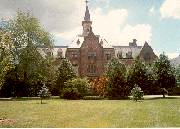 Presidents Hall is the centerpiece of the campus. It was built in 1867 on the site of the Elphinstone Mansion, a marble villa
which Seton Hall obtained when it purchased the Elphinstone estate as a campus. Only two stones in the foundation remain
from the original villa. The first floor of the Hall is paneled with wood from Sussex County chestnut trees, and its halls are
lined with portraits of past presidents. The stained glass window of St. Elizabeth Ann Seton was commissioned in 1866 by
her nephew, Bishop James Roosevelt Bayley, the founder of Seton Hall.
Presidents Hall is the centerpiece of the campus. It was built in 1867 on the site of the Elphinstone Mansion, a marble villa
which Seton Hall obtained when it purchased the Elphinstone estate as a campus. Only two stones in the foundation remain
from the original villa. The first floor of the Hall is paneled with wood from Sussex County chestnut trees, and its halls are
lined with portraits of past presidents. The stained glass window of St. Elizabeth Ann Seton was commissioned in 1866 by
her nephew, Bishop James Roosevelt Bayley, the founder of Seton Hall.
For a complete campus map with pictures of all buildings on the main campus, please select More Info on top of this page.